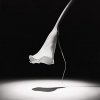Rob MacKillop
Edinburgh Correspondent
I'm glad this is a theme and not a competition, in that the end result is, for me, not as important as the journey. That's why I thought of jotting down my thoughts and experiences as I go about acquiring and shooting the Calla Lily. Your comments are welcome, though don't feel you have to respond to every update I make.
The theme has come at the right time for me, as I have started exploring still life photography, and flower shots have a long tradition in that genre. Although my comments so far in that regard have been to do with mastering exposure, my private thoughts have been more about the meaning of the final image, and also the meaning of the engagement in doing any form of still life.
We have a photography gallery in the centre of Edinburgh called Stills, and the word has been used for decades in contradistinction to movies. There is the sense that a still-life image is of something that has been caught in a moment - the arrangement "just so", the light "just so". But this is an illusion, as life - including the life of the still image - is constantly in flow. I'm reminded of the ancient Greek philosopher, Heraclitus, saying that "One can and cannot step into the same river twice" - the river is the same, but the waters are constantly new.
To develop this idea of the two rivers: One river is the image, apparently always the same, and able to be reproduced in an identical way. The other river is the living experience of both the viewer and the flower - forever flowing, never for a moment the same. It is this contradiction which lies at the heart of the Still Life, the two-word description being wholly apt.
There is also another slant to the word "still", as in "The river is still flowing" - a continuance, giving birth to new life. The word play is something that appeals to me.
I went to a local flower shop today, and asked for a Calla or Arum lily. The lady said she had one in the back. She came up with four, which she claimed were set aside for another job which only required three. So I was given one - no choice was allowed. At first glance they all looked the same to me, so I accepted the offering. It cost £3. What surprised me was that it did not look like what I was expecting: white petals and a yellow protrudence. This one is red or dark pink, with the central part hidden beneath the folds of the leaves or petals. It seems I have a lot to learn about this flower.
It sits in an old beer bottle on my desk. Here's a quick, careless iPhone snap, as I write this. It'll do for now. Our relationship has just begun. We both have much to learn.
That's enough for one day!

The theme has come at the right time for me, as I have started exploring still life photography, and flower shots have a long tradition in that genre. Although my comments so far in that regard have been to do with mastering exposure, my private thoughts have been more about the meaning of the final image, and also the meaning of the engagement in doing any form of still life.
We have a photography gallery in the centre of Edinburgh called Stills, and the word has been used for decades in contradistinction to movies. There is the sense that a still-life image is of something that has been caught in a moment - the arrangement "just so", the light "just so". But this is an illusion, as life - including the life of the still image - is constantly in flow. I'm reminded of the ancient Greek philosopher, Heraclitus, saying that "One can and cannot step into the same river twice" - the river is the same, but the waters are constantly new.
To develop this idea of the two rivers: One river is the image, apparently always the same, and able to be reproduced in an identical way. The other river is the living experience of both the viewer and the flower - forever flowing, never for a moment the same. It is this contradiction which lies at the heart of the Still Life, the two-word description being wholly apt.
There is also another slant to the word "still", as in "The river is still flowing" - a continuance, giving birth to new life. The word play is something that appeals to me.
I went to a local flower shop today, and asked for a Calla or Arum lily. The lady said she had one in the back. She came up with four, which she claimed were set aside for another job which only required three. So I was given one - no choice was allowed. At first glance they all looked the same to me, so I accepted the offering. It cost £3. What surprised me was that it did not look like what I was expecting: white petals and a yellow protrudence. This one is red or dark pink, with the central part hidden beneath the folds of the leaves or petals. It seems I have a lot to learn about this flower.
It sits in an old beer bottle on my desk. Here's a quick, careless iPhone snap, as I write this. It'll do for now. Our relationship has just begun. We both have much to learn.
That's enough for one day!





